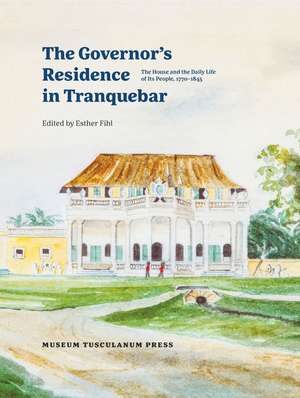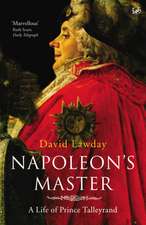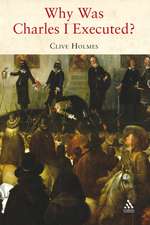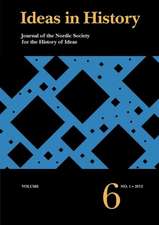The Governor's Residence in Tranquebar: The House and the Daily Life of Its People, 1750-1845
Autor Esther Fihlen Limba Engleză Hardback – 15 ian 2018
The history of contacts between India and Europe tends to be dominated by the British, but Denmark also played a role on the subcontinent in the colonial era. This book offers insight into that history via a close look at one very specific part of it: the house in which the Danish colonial governor lived in Tranquebar, on the Coromandel Coast. We meet the governors and their Indian staffs and see their interactions with traders, temple priests, and princely delegates. With the help of hundreds of illustrations from the period, the resulting book is a fascinating portrait of the vibrantly multicultural life of a small colonial outpost in the eighteenth and nineteenth centuries.
Preț: 382.50 lei
Preț vechi: 456.19 lei
-16% Nou
Puncte Express: 574
Preț estimativ în valută:
73.21€ • 79.55$ • 61.54£
73.21€ • 79.55$ • 61.54£
Carte disponibilă
Livrare economică 31 martie-14 aprilie
Preluare comenzi: 021 569.72.76
Specificații
ISBN-13: 9788763543880
ISBN-10: 8763543885
Pagini: 432
Dimensiuni: 229 x 298 x 33 mm
Greutate: 1.78 kg
Editura: Museum Tusculanum Press
Colecția Museum Tusculanum Press
ISBN-10: 8763543885
Pagini: 432
Dimensiuni: 229 x 298 x 33 mm
Greutate: 1.78 kg
Editura: Museum Tusculanum Press
Colecția Museum Tusculanum Press
Notă biografică
Esther Fihl is an anthropologist and professor in the Department of Cross-Cultural and Regional Studies at the University of Copenhagen, where she is also the leader of the Centre for Competitive Cultural Studies.
Recenzii
"The Governor’s Residence in Tranquebar is a monumental work, which brings to us detailed essays by different authors on the historical legacy of the Danish Governor’s house in Tharagampadi, otherwise known as Tranquebar. By looking at maps, architectural drawings, renovation plans by contemporary architects, photographs taken in the 19th century, and what is called Company Art, a huge corpus of materials is brought to our attention. The authors provide us with many illustrations, which make the text more lucid. The biographical details of the Governors and their support staff, whether it be women of the family, or dominant or subservient castes who help them carry out their work, is an eye opener. Their often tragic love stories, when companions die, show the intensity of their passions. The story of how [governor Peder Hansen] pursued [his wife Harriet] and won her, though she died at 29 after having borne him eight children, is told with great style."
"A skilfully crafted book that is lucid, imaginative and comprehensible to a wide audience.
Through a narrative interspersed with anecdotes, illustrations, maps, photographs and excerpts from archival materials, the book paints a vivid portrait of the past as it unfolded in the life of the Governor’s house and its people. Written by historians, anthropologists, architects and restorers, the book has rich descriptions about the architectural splendour of the house, the material artefacts that adorned it, and the utilisation of space within it. . . . Although the book may be taken for just another “coffee table book”, it is far from one. It is a book designed to be read closely, not merely casually looked at or glanced through. It is rich in description and detail. The elaborate and colourful anecdotes, images, illustrations, maps, architectural plans and photographs that appear with the main text deserve to be read on their own terms . . . and provide a much better understanding of the people, places and times that are being referred to."
Through a narrative interspersed with anecdotes, illustrations, maps, photographs and excerpts from archival materials, the book paints a vivid portrait of the past as it unfolded in the life of the Governor’s house and its people. Written by historians, anthropologists, architects and restorers, the book has rich descriptions about the architectural splendour of the house, the material artefacts that adorned it, and the utilisation of space within it. . . . Although the book may be taken for just another “coffee table book”, it is far from one. It is a book designed to be read closely, not merely casually looked at or glanced through. It is rich in description and detail. The elaborate and colourful anecdotes, images, illustrations, maps, architectural plans and photographs that appear with the main text deserve to be read on their own terms . . . and provide a much better understanding of the people, places and times that are being referred to."
"The Governor’s Residence in Tranquebar offers a new and refreshing analytical perspective in the historiography on Danish colonialism because it employs the governor’s residence, everything and everyone in it and all that took place there as a prism through which the authors can analyse previously understudied aspects of the multilayered and multicultural life in colonial Tranquebar and beyond. . . . The approach in The Governor’s Residence to the house as a prism is further enhanced by the inclusion in the text of 25 ‘vignettes’ and many more illustrations. The vignettes are small stories focusing on a person, an object or a theme that branch off from the main narrative but still informs it. The many beautiful illustrations, at least one on each double-page and many of them never published before, also support the narrative, especially since the captions are substantial and form yet another layer of minor stories.
The Governor’s Residence in Tranquebar is a well-written anthology based on solid research and with refreshing analytical perspectives that point out new directions for further research. Yet, at the same time, its skilfully crafted mosaic of vignettes and rich illustrations will also make it accessible and an interesting read for the broader audience and not just for those with scholarly interests."
The Governor’s Residence in Tranquebar is a well-written anthology based on solid research and with refreshing analytical perspectives that point out new directions for further research. Yet, at the same time, its skilfully crafted mosaic of vignettes and rich illustrations will also make it accessible and an interesting read for the broader audience and not just for those with scholarly interests."














